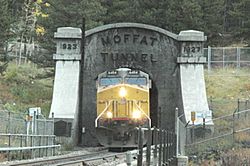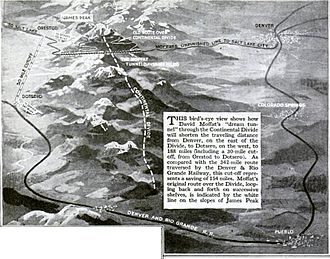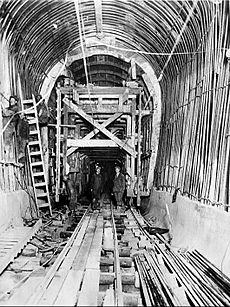Moffat Tunnel facts for kids
 |
|
| The western entrance to the tunnel | |
| Overview | |
|---|---|
| Location | Colorado, USA |
| System | Union Pacific Railroad |
| Technical | |
| Length | 6.2 miles (10.0 km) |
| Gauge | 4 ft 8 1⁄2 in (1,435 mm) standard gauge |
| Highest elevation | 9,239 feet (2,816 m) above sea level |
| Tunnel clearance | 24 feet (7.3 m) |
| Width | 18 feet (5.5 m) |
| Grade | 1 in 125 (0.8%) |
The Moffat Tunnel is a special tunnel in central Colorado. It's used by both trains and water! It goes right through the Continental Divide, which is like a giant mountain ridge that separates rivers flowing to different oceans.
It's named after David Moffat, a railroad pioneer from Colorado. The first train went through the tunnel in February 1928. Before this tunnel, Denver didn't have a direct train route west through the mountains. Other cities like Cheyenne, Wyoming, and Pueblo already had train access to the West Coast.
The Moffat Tunnel follows the path Moffat planned in 1902. He wanted a shorter and better way to get from Denver to Salt Lake City. Today, about 15 trains use the tunnel every day. Right next to the train tunnel is a water tunnel. This water tunnel helps bring part of Denver's water supply to the city. In 1979, the tunnel was named a National Historic Civil Engineering Landmark. This means it's a very important engineering achievement!
Contents
Exploring the Moffat Tunnel
The eastern entrance of the tunnel is about 50 miles (80 km) west of Denver. It's near the town of Rollinsville. The western entrance is at the Winter Park Resort ski area. This side leads towards Salt Lake City.
The train tunnel is 24 feet (7.3 m) high and 18 feet (5.5 m) wide. It stretches for 6.2 miles (10.0 km) (about 10 kilometers). The highest point inside the tunnel is 9,239 feet (2,816 m) above sea level. The tunnel also has a gentle slope of 1 in 125 (0.8%).
Back in 1989, the Moffat Tunnel was the fourth longest train tunnel in North America. It was also the longest tunnel that didn't use electricity for trains until 1956. That's when the Cascade Tunnel stopped using electricity.
The tunnel has only one track. This means only one train can go through at a time. Trains usually take turns, with one going east and then one going west.
How the Tunnel Stays Clear
The tunnel has a special system to clear out train exhaust. After a train leaves, huge fans turn on. Doors at both ends of the tunnel close before the fans start. This helps push the air through.
In the past, trains had to wait 20-30 minutes before entering. This was to make sure the air was clear. Today, sensors check the air quality. Lighter trains, like Amtrak passenger trains, might only need to wait less than 20 minutes.
The Tunnel's Interesting History
The idea for the Moffat Tunnel came from David Moffat around 1902. He was part of the Denver, Northwestern and Pacific (DNW&P) railroad. The original train tracks had to climb Rollins Pass. This route had very steep sections and lots of snow. Clearing the snow made it too expensive to run trains.
Moffat tried to get enough money to build the tunnel, but he passed away in 1911. However, others continued his dream. In 1914, Denver voters approved money for two-thirds of the tunnel's cost. But a court said Denver couldn't join with a private company to build it.
In 1920, a plan was suggested to build three tunnels. But different parts of Colorado couldn't agree. Southern areas worried that Denver would get too much business from the Moffat Tunnel. This disagreement actually helped Denver later on.
In 1922, Denver lawmakers found a way forward. The city of Pueblo had a terrible flood. The governor called an emergency meeting of the state legislature. Denver lawmakers offered to vote for emergency money for Pueblo. In return, they asked for a law to allow Denver to sell bonds for its tunnel. A deal was made! On April 29, the Moffat Tunnel Improvement District was created.
This district included Denver and parts of other counties. It could collect taxes and sell bonds. Bonds are like loans that people buy to help fund big projects. Construction started that summer. The bonds were fully paid off in December 1983.
In 1988, the company that owned the Denver and Rio Grande Western Railroad bought the Southern Pacific Railroad. Later, in 1996, the combined company was sold to the Union Pacific Railroad.
Today, the tunnel is mainly used for carrying coal and other goods by train. It also brings water from the western side of the Continental Divide to Denver. The California Zephyr passenger train also uses the tunnel. The tunnel's highest point is the highest on the entire Amtrak train network! The Winter Park Express train also uses it.
Building the Moffat Tunnel
The Moffat Tunnel was dug under a part of James Peak. A smaller, pilot tunnel was dug first. It was parallel to the main tunnel, about 75 feet (23 m) south of it. This pilot tunnel was eight feet (2.4 m) high and eight feet (2.4 m) wide. It helped with the construction work.
In 1925, bad rock at the west end caused delays and higher costs. The pilot tunnel was finally "holed through" on February 18, 1927. President Calvin Coolidge even set off the final dynamite blast from Washington, D.C.! The event was broadcast on the radio from inside the mountain. This pilot tunnel later became the water tunnel. More bonds had to be sold to finish the project.
The main train tunnel was "holed through" on July 7, 1927. It was officially handed over for use on February 26, 1928. Five years later, another section of track called the Dotsero Cutoff was finished. This made the train journey between Denver and the Pacific coast 176 miles (283 km) shorter.
The tunnel took 48 months to dig. Workers made an average of 21 feet (6.4 m) of progress each day. The first train went through in February 1928.
The original cost was estimated at $6.62 million. But the final cost, including interest, was about $24 million. The two tunnels together cost $15.6 million. This was about $475 for every foot of tunnel dug. The fancy bronze letters on the tunnel entrances each cost $40. The dates 1923 (when building started) and 1927 (when it was supposed to finish) are on the entrances. They didn't change 1927 to 1928 (when it actually opened) to save $80!
The project dug out 750,000 cubic yards (570,000 m3) of rock. That's like 1,600 freight trains, each with 40 cars! Sadly, 28 people died during the five-year project. Six died in one accident on July 30, 1926.
The train tracks inside the tunnel were first made of many short pieces. But in the 1930s, they were replaced with long, continuous pieces of rail. This was because the smoke from coal trains and steam from engines caused rust where the short pieces joined.
The Water Tunnel's Purpose
The smaller pilot tunnel was rented to the City of Denver. It's used as a water tunnel. It helps move water from the Colorado River Basin on the west side of the Continental Divide. This water then flows east to the cities on the eastern side.
The pilot tunnel was made wider, to 10.5 feet (3.2 m) in diameter. This allows it to carry a lot of water, about 1,280 cubic feet per second (36 m3/s). Water started flowing through it in 1936. In 1979, the water tunnel was sold to the city of Denver. Since the 1940s, it has also carried water for the city of Englewood.
Some of the water that goes through the Moffat Tunnel to Denver actually crosses the Continental Divide three times! This water comes from Denver's Williams Fork collection system. It first goes east through the Gumlick Tunnel under Jones Pass. Then it flows north through the Vasquez Tunnel into the Fraser River valley. Finally, it reaches the Moffat Tunnel.
Modern Updates
From May 2018 to November 2019, the roof of the East Portal of the Moffat Tunnel was replaced. It was a big project, covering 14,200 square feet!
East Portal Camp Cabins
On January 30, 2020, five old cabins near the East Portal of the Moffat Tunnel were listed as one of Colorado's Most Endangered Places. These cabins are next to Rollins Pass.



